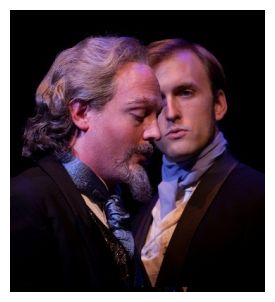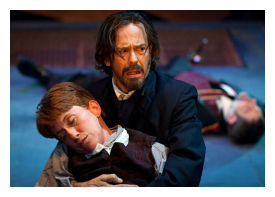Review: Hamlet by Austin Shakespeare
by Michael Meigs
 The question that must be addressed when discussing this Hamlet staged by Austin Shakespeare is not "Why cast Helen Merino for the title role?" but rather "What does casting Helen Merino as Hamlet do to the play?"
The question that must be addressed when discussing this Hamlet staged by Austin Shakespeare is not "Why cast Helen Merino for the title role?" but rather "What does casting Helen Merino as Hamlet do to the play?"
Merino played Hamlet ten years ago for the same organization, then known as the Austin Shakespeare Festival, at free performances in Zilker Park downtown. She was an Austin favorite at that time; a 2001 article in the weekly Austin Chronicle identified her as one of the 40 "most valuable players" on Austin stages. Merino returned to Austin to play the title role in Schiller's Mary Stuart in February, 2010, and won a B. Iden Payne award for it, the highest recognition voted by members of the Austin theatre community. We know that she's a pro, and the prospect of seeing her in Shakespeare is a draw. But what happens to the play?
Director Ann Ciccolella crafts a vigorous, professional production, as always, with highly talented actors, many of whom we've seen before in Austin Shakespeare productions. She gives Merino the straightforward task of portraying a man, a prince, a would-be sovereign haunted by the questionable ghost of his father -- represented here with the ingenuity of puppetry as a 15-foot-tall spectre with a voice like that of Darth Vader. The puppetry is credited to Gary Jaffe.
Merino's Hamlet is androgynous, cerebral, and dismissive. Polonius had it right when he warned his daughter Ophelia "Lord Hamlet is a prince out of thy star" (II, ii). This Hamlet has neither the brawn of a man nor the affect of a woman; he/she reminds me strongly of a daughter of French landed aristocrats whom we had the odd chance to meet in our younger days. There was not a silver spoon in that mouth, but rather a whole set of gleaming silver tableware. Like that very foreign person, Merino as Hamlet has a self assurance born of privilege and a self-absorption quite incomprehensible to ordinary mortals.
 There's little heart in this Hamlet, and indeed, Ophelia was the more deceived by any professions of affection. Merino cuts off and insults Rosencrantz and Guildenstern, who are visibly surprised and offended. Hamlet has an uncommon command of language, almost an Aspergian brilliance -- remember the near perfect recitation of Aeneas' tale to Dido, not acted more than once -- as well as the Aspergian "difficulties in social interaction." We are conditioned by long exposure to this play to love Hamlet for the complexity and depth of his language and thought, and it is only gradually during the three hours of this action that we may begin to lose our sympathy for this cold, self-despising child of privilege.
There's little heart in this Hamlet, and indeed, Ophelia was the more deceived by any professions of affection. Merino cuts off and insults Rosencrantz and Guildenstern, who are visibly surprised and offended. Hamlet has an uncommon command of language, almost an Aspergian brilliance -- remember the near perfect recitation of Aeneas' tale to Dido, not acted more than once -- as well as the Aspergian "difficulties in social interaction." We are conditioned by long exposure to this play to love Hamlet for the complexity and depth of his language and thought, and it is only gradually during the three hours of this action that we may begin to lose our sympathy for this cold, self-despising child of privilege.
The questions of age, masculinity and maturity come starkly into focus in Hamlet's relationship with Horatio. Michael Dalmon in that role is wiry, intelligent, masculine and open in his affections -- in fact, demonstrating just the maturity that this Hamlet lacks. We do not know why Horatio remains in Hamlet's affections while the prince dispatches his duped 'good friends' Rosencrantz and Guildenstern to sudden death, no shriving allowed. Shakespeare gives no explanation other than perhaps Horatio's 'philosophy,' and this staging does not elaborate upon that.
 Scott Shipman plays Polonius as a swishy fool, which is most unfortunate. The rest of the cast reacts to that characterization. In my view, Polonius may be sententious, but he is acknowledged to be a statesman of long date who advised King Hamlet as well as Claudius. As happens very often, the director and cast take Hamlet's gibes as gospel and turn the character into comic relief. His death gains in meaning if one understands that he is a man of worth and consequence.
Scott Shipman plays Polonius as a swishy fool, which is most unfortunate. The rest of the cast reacts to that characterization. In my view, Polonius may be sententious, but he is acknowledged to be a statesman of long date who advised King Hamlet as well as Claudius. As happens very often, the director and cast take Hamlet's gibes as gospel and turn the character into comic relief. His death gains in meaning if one understands that he is a man of worth and consequence.
The time period is undefined and Pam Fletcher Friday's costumes are a mixture of Edwardian and early Victorian dress. Ophelia's white gathered gown resembles something out of the illustrations of Dante Gabriel Rosettei. Philip Kreyche as rebellious Laertes comes onstage carrying a carbine.
 Standing out among a very accomplished cast is Barry Pineo, actor, teacher and theatre reviewer for the Austin Chronicle, as the player king and the gravedigger -- the first with attentive dignity and the second with a roustabout humor. The director would have done well to enlist him for Act V as one of the ambassadors from England; it was disconcerting to see Steve Cruz, a doughty Rosencrantz, returned to announce his own death. And while I'm nit-picking: concerning the grave itself, a commodious opening in the center stage platform -- why didn't the players lower Ophelia into that tomb rather than leaving her bier front and center, where Chelsea Duvall was clearly visible scrambling off stage after the lights had faded on V, i?
Standing out among a very accomplished cast is Barry Pineo, actor, teacher and theatre reviewer for the Austin Chronicle, as the player king and the gravedigger -- the first with attentive dignity and the second with a roustabout humor. The director would have done well to enlist him for Act V as one of the ambassadors from England; it was disconcerting to see Steve Cruz, a doughty Rosencrantz, returned to announce his own death. And while I'm nit-picking: concerning the grave itself, a commodious opening in the center stage platform -- why didn't the players lower Ophelia into that tomb rather than leaving her bier front and center, where Chelsea Duvall was clearly visible scrambling off stage after the lights had faded on V, i?
 The finale is swift and dramatic, with the complex clash of foils choreographed by fight coordinator Toby Minor. The ending, with Hamlet's final gasp "The rest is silence" and a distraught Horatio clasping the dead prince, is memorable.
The finale is swift and dramatic, with the complex clash of foils choreographed by fight coordinator Toby Minor. The ending, with Hamlet's final gasp "The rest is silence" and a distraught Horatio clasping the dead prince, is memorable.
Austin Shakespeare's Hamlet is a riveting evening, despite the questions and issues that this staging raises. It plays its final weekend at the Rollins 'black box' Theatre at the Long Center from Friday, October 7 through Sunday, October 9.
Review by Jillian Owens for the Austin Chronicle, September 29
Review by Karie Metzer at www.austinpost.com, October 5
EXTRAS
Click to view images by Kimberley Mead of the dress rehearsal of Austin Shakespeare's Hamlet
Click to go to video montage of scenes from Austin Shakespeare's Hamlet
Click to view excerpts from the program for Austin Shakespeare's Hamlet
Hits as of 2015 03 01: 2847
Hamlet
by William Shakespeare
Austin Shakespeare
